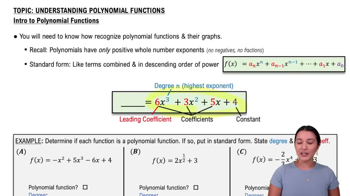Table of contents
- 0. Functions7h 52m
- Introduction to Functions16m
- Piecewise Functions10m
- Properties of Functions9m
- Common Functions1h 8m
- Transformations5m
- Combining Functions27m
- Exponent rules32m
- Exponential Functions28m
- Logarithmic Functions24m
- Properties of Logarithms34m
- Exponential & Logarithmic Equations35m
- Introduction to Trigonometric Functions38m
- Graphs of Trigonometric Functions44m
- Trigonometric Identities47m
- Inverse Trigonometric Functions48m
- 1. Limits and Continuity2h 2m
- 2. Intro to Derivatives1h 33m
- 3. Techniques of Differentiation3h 18m
- 4. Applications of Derivatives2h 38m
- 5. Graphical Applications of Derivatives6h 2m
- 6. Derivatives of Inverse, Exponential, & Logarithmic Functions2h 37m
- 7. Antiderivatives & Indefinite Integrals1h 26m
- 8. Definite Integrals4h 44m
- 9. Graphical Applications of Integrals2h 27m
- 10. Physics Applications of Integrals 2h 22m
4. Applications of Derivatives
Motion Analysis
Problem 3.6.25c
Textbook Question
Suppose a stone is thrown vertically upward from the edge of a cliff on Earth with an initial velocity of 64 ft/s from a height of 32 ft above the ground. The height (in feet) of the stone above the ground t seconds after it is thrown is s(t) = -16t²+64t+32.
c. What is the height of the stone at the highest point?
 Verified step by step guidance
Verified step by step guidance1
To find the height of the stone at the highest point, we need to determine when the stone reaches its maximum height. This occurs at the vertex of the parabolic function s(t) = -16t² + 64t + 32.
The vertex of a parabola given by the equation s(t) = at² + bt + c can be found using the formula t = -b/(2a). Here, a = -16 and b = 64.
Substitute the values of a and b into the formula: t = -64/(2 * -16). Simplify this expression to find the time t at which the stone reaches its maximum height.
Once you have the value of t, substitute it back into the original height function s(t) = -16t² + 64t + 32 to find the height of the stone at this time.
Calculate s(t) using the value of t found in the previous step to determine the maximum height of the stone above the ground.
 Verified video answer for a similar problem:
Verified video answer for a similar problem:This video solution was recommended by our tutors as helpful for the problem above
Video duration:
4mPlay a video:
Was this helpful?
Key Concepts
Here are the essential concepts you must grasp in order to answer the question correctly.
Quadratic Functions
The height of the stone is modeled by a quadratic function, s(t) = -16t² + 64t + 32. Quadratic functions are polynomial functions of degree two, characterized by their parabolic shape. The coefficients determine the direction of the parabola and its vertex, which represents the maximum or minimum point of the function.
Recommended video:

Introduction to Polynomial Functions
Vertex of a Parabola
The highest point of a parabola represented by a quadratic function occurs at its vertex. For a function in the form s(t) = at² + bt + c, the t-coordinate of the vertex can be found using the formula t = -b/(2a). This point gives the time at which the stone reaches its maximum height, which is essential for solving the problem.
Recommended video:

Properties of Parabolas
Maximizing Height
To find the maximum height of the stone, we substitute the t-coordinate of the vertex back into the height function s(t). This process allows us to determine the maximum value of the function, which corresponds to the highest point the stone reaches during its flight. Understanding this step is crucial for answering the question accurately.
Recommended video:

Maximizing Profit & Revenue

 6:29m
6:29mWatch next
Master Derivatives Applied To Velocity with a bite sized video explanation from Nick
Start learning




